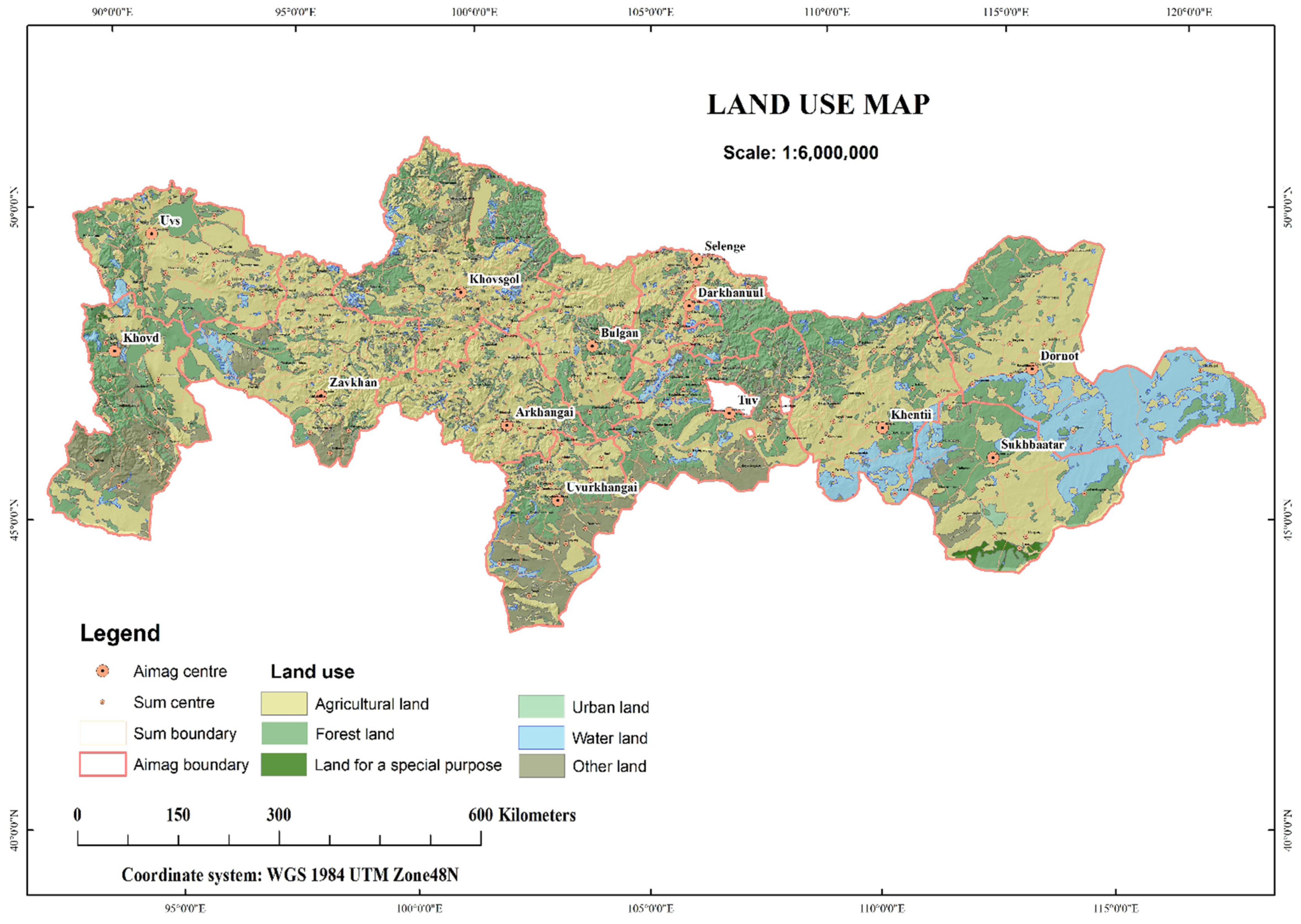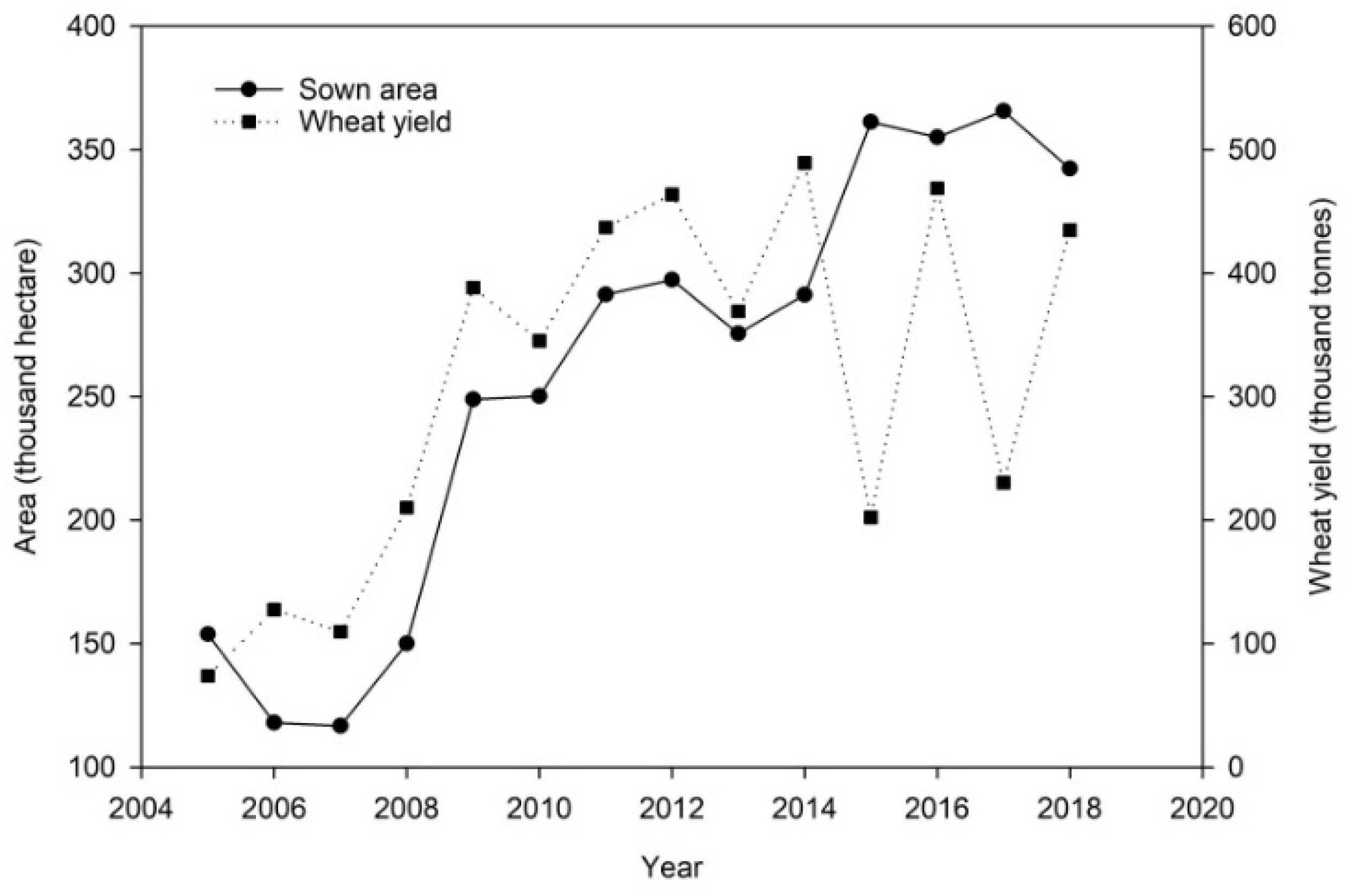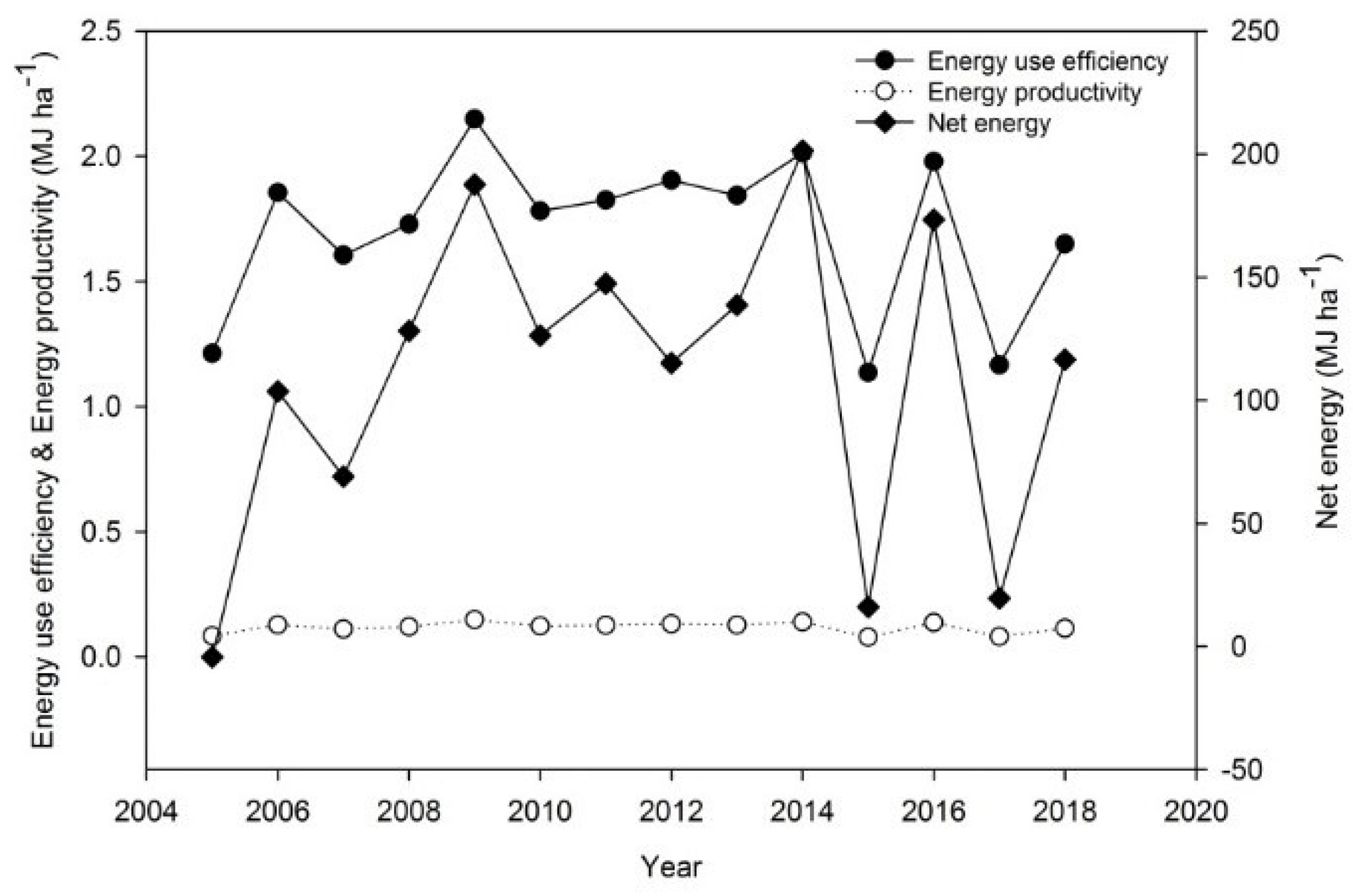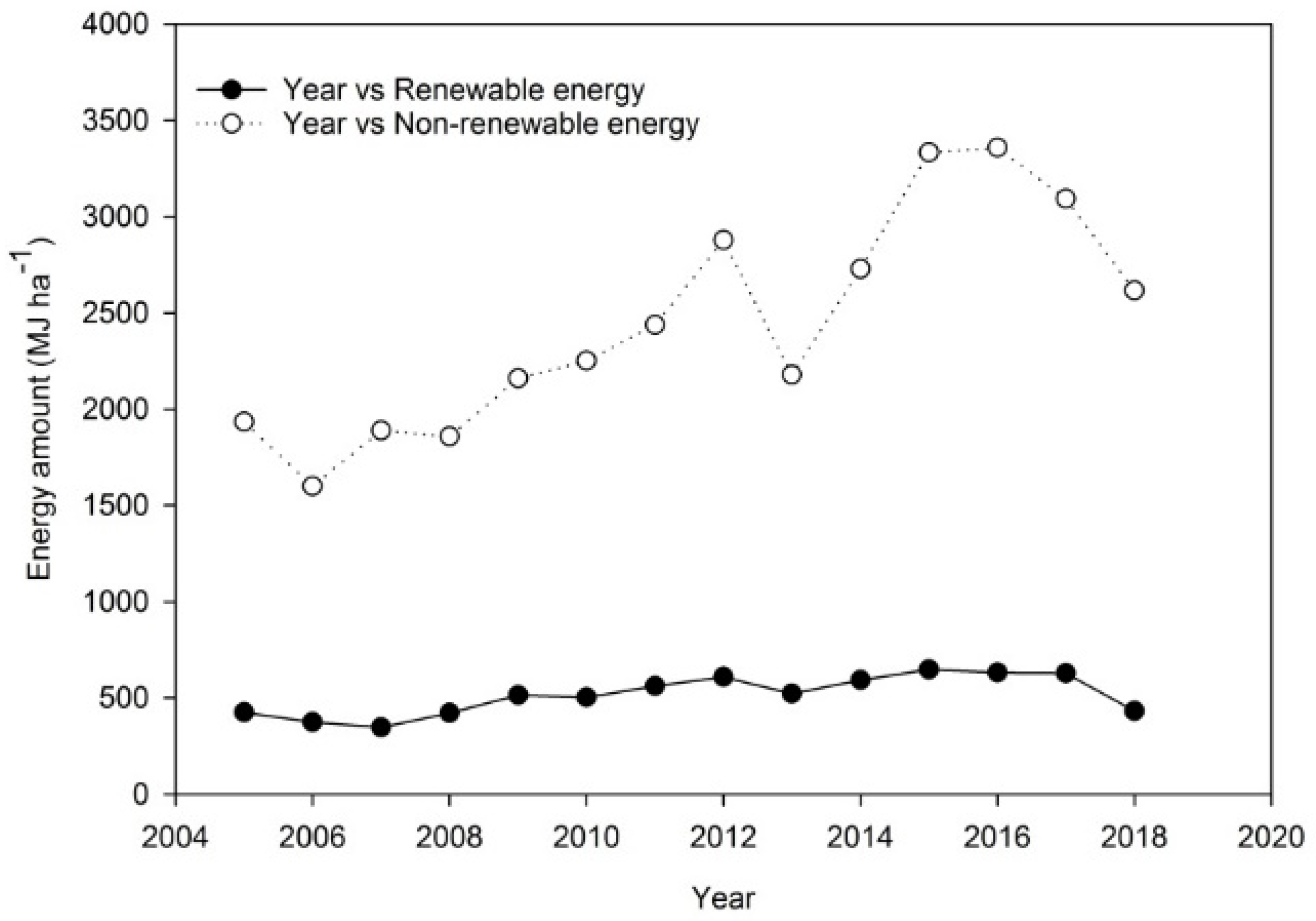Energy Analysis on Wheat Yield of Mongolian Agriculture
Abstract
1. Introduction
2. Materials and Methods
2.1. Data Sources
2.2. Calculation Method
3. Results and Discussion
3.1. Energy Use for Wheat Production
3.2. The Econometric Results for Energy Use
4. Conclusions
- (1)
- Utilize innovative and technological machinery and equipment (which may have a higher price than old machinery, but will reduce diesel fuel use and save working hours).
- (2)
- Make use of newly tested seeds (disease resistance and drought tolerance have to be high).
- (3)
- Expand the use of green manures (leverage the high number of livestock).
- (4)
- Reduce the need for chemical fertilizer. It is feasible to boost agricultural output by increasing renewable energy inputs; authorities should focus on ensuring environmentally sustainable energy usage in Mongolian agriculture.
Author Contributions
Funding
Informed Consent Statement
Data Availability Statement
Acknowledgments
Conflicts of Interest
References
- FAO. The Water-Energy-Food Nexus—A New Approach in Support of Food Security and Sustainable Agriculture; FAO: Rome, Italy, 2014; Available online: www.fao.org/nr/water/docs/fao_nexus_concept_web.pdf (accessed on 15 October 2021).
- Dalhberg, K.A. Sustainable agriculture-fad or harbinger? Bioscience 1991, 41, 337–340. [Google Scholar] [CrossRef]
- Knorr, D.; Watkins, T.R. Alterations in Food Production; Van Nostrand Reinhold: New York, NY, USA, 1984. [Google Scholar]
- Bidwell, O.W. Where do we stand on sustainable agriculture? J. Soil Water Conserv. 1986, 41, 317–320. [Google Scholar]
- Carter, H.O. Agricultural sustainability: An overview and research assessment. Calif. Agric. 1989, 43, 16–18, 37. [Google Scholar]
- Macrae, R.J.; Hill, S.B.; Mehuys, G.R.; Henning, J. Agricultural science and sustainable agriculture, a review of the existing scientific barriers to sustainable food production and potential solutions. Biol. Agric. Hortic. 1989, 6, 173–219. [Google Scholar] [CrossRef]
- Kuesters, J.; Lammel, J. Investigation of the energy efficiency of the production of winter wheat and sugar beet in Europe. Eur. J. Agron. 1999, 11, 35–43. [Google Scholar] [CrossRef]
- Nergui, D.; Ganbaatar, S. The Chronicle for Farmers of Mongolian Agriculture; Munkhiin Useg Press: Ulaanbaatar, Mongolia, 2009. [Google Scholar]
- Asian Development Bank. Unlocking Mongolia’s Rich Renewable Energy Potential; The Asian Development Bank (ADB): Ulaanbaatar, Mongolia, 2020; Available online: https://www.adb.org/news/features/unlocking-mongolias-rich-renewable-energy-potential (accessed on 22 April 2020).
- Amar, U.; Robert, M. Estimating Armington elasticities for wheat in Mongolia. Sustain. Dev. Agric. Econ. 2018, 9, 90–92. [Google Scholar]
- Mongolian Food Supply Law. National Legal Information Center. 1995. Available online: www.legalinfo.mn (accessed on 13 December 2021).
- Ministry of Food and Agriculture. Third ‘Atar’ Campaign. Report of National Program on Development Arable Land; UB Print Press: Ulaanbaatar, Mongolia, 2009. [Google Scholar]
- National Statistics of Agriculture. Mongolian National Statistical Information Service. 2019. Available online: www.1212.mn/stat.asp (accessed on 16 March 2021).
- Amar, U.; Robert, M. Import demand analysis for wheat in Mongolia. Econ. Work. Cap. 2019, 3, 92–95. [Google Scholar]
- FAO. Food and Agricuture Organization of the United Nations. Available online: www.fao.org (accessed on 13 December 2021).
- Natsagdorj, E.; Renchin, T.; Kappas, M.; Tseveen, B.; Dari, C.; Tsend, O.; Duger, U.O. An integrated methodology for soil moisture analysis using multispectral data in Mongolia. Geo-Spat. Inf. Sci. 2017, 21, 46–55. [Google Scholar] [CrossRef][Green Version]
- Eren, Y. A study on utilization period of tractors in Turkey. In Proceedings of the 13th National Agricultural Mechanization Congress, Konya, Turkey, 30 May–15 June 1991; pp. 514–519. [Google Scholar]
- Canakci, M.; Akinci, I. Energy use pattern analysis of greenhouse vegetable production. Energy 2006, 31, 1243–1256. [Google Scholar] [CrossRef]
- Bekei, A. The Economic of Mongolian Agriculture; MULS Press: Ulaanbaatar, Mongolia, 2018. [Google Scholar]
- Punsaldulam, B. History of Mongolian Agriculture 1959–2019; Munkhiin Useg Press: Ulaanbaatar, Mongolia, 2020. [Google Scholar]
- Celling, C.E.; Parmenter, K.E. Energy efficiency in fertilizer production and use. In Efficient Use and Conservation of Energy 8 Encyclopedia of Life Support Systems; Cellings, C.W., Ed.; Eolss Publishers: Oxford, UK, 2004; pp. 123–136. [Google Scholar]
- Esengun, K.; Erdal, G.; Gunduz, O.; Erdal, H. An economic analysis and energy use in stake-tomato production in Tokat province of Turkey. Renew. Energy 2007, 32, 1873–1881. [Google Scholar] [CrossRef]
- Yilmaz, I.; Akcaoz, H.; Ozkan, B.B. An analysis of energy use and input costs for cotton production in Turkey. Renew. Energy 2005, 30, 145–155. [Google Scholar] [CrossRef]
- Mohammadi, A.; Tabatabaeefar, A.; Shahin, S.H.; Rafiee, S.H.; Keyhani, A. Energy use and economical analysis of potato production in Iran case study: Ardabil province. Energy Convers. Manag. 2008, 49, 3566–3570. [Google Scholar] [CrossRef]
- Singh, H.; Mishra, D.; Nahar, N.M. Energy use pattern in production agriculture of typical village in arid zone, India-part I. Energy Convers. Manag. 2002, 43, 2275–2286. [Google Scholar] [CrossRef]
- Hatirli, S.A.; Ozkan, B.; Fert, C. An econometric analysis of energy input-output in Turkish agriculture. Renew. Sustain. Energy Rev. 2005, 9, 608–623. [Google Scholar] [CrossRef]
- Singh, S.; Singh, S.; Pannu, C.J.S.; Singh, J. Energy input and yield relations for wheat in different agro-climatic zones of the Punjab. Appl. Energy 1999, 63, 287–298. [Google Scholar] [CrossRef]
- Ozkan, B.; Akcoaz, H.; Fert, C. Energy input-output analysis in Turkish agriculture. Renew. Energy 2004, 29, 39–51. [Google Scholar] [CrossRef]
- Rafiee, S.; Mousavi Avval, S.H.; Mohammadi, A. Modeling and sensitivity analysis of energy inputs for apple production in Iran. Energy 2010, 35, 3301–3306. [Google Scholar] [CrossRef]
- Heidari, S.A.; Omid, M. Energy use patterns and econometric models of major greenhouse vegetable productions in Iran. Energy 2011, 36, 220–225. [Google Scholar] [CrossRef]
- Samavatean, N.; Rafiee, S.; Mobli, H.; Mohammadi, A. An analysis of energy use and relation between energy inputs and yield, costs and income of garlic production in Iran. Renew. Energy 2011, 36, 1808–1813. [Google Scholar] [CrossRef]
- Nguyen, T.L.T.; Gheewala, S.H.; Garivait, S. Energy balance and GHG-abatement cost of cassava utilization for fuel ethanol in Thailand. Energy Policy 2007, 35, 4585–4596. [Google Scholar] [CrossRef]
- Mobtaker, H.G.; Akram, A.; Keyhani, A. Energy use and sensitivity analysis of energy inputs for alfalfa production in Iran. Energy Sustain. Dev. 2012, 16, 84–89. [Google Scholar] [CrossRef]
- Stata User’s Guide Release 13; Stata Corporation: College Station, TX, USA, 2013.
- Yildiz, T. An Input-Output Energy Analysis of Wheat Production in Çarşamba District of Samsun Province. J. Agric. Fac. Gaziosmanpasa Univ. 2016, 33, 10–20. [Google Scholar] [CrossRef]
- Ilahi, S.; Wu, Y.; Raza, M.A.A.; Wei, W.; Imran, M.; Bayasgalankhuu, L. Optimization Approach for Improving Energy Efficiency and Evaluation of Greenhouse Gas Emission of Wheat Crop using Data Envelopment Analysis. Sustainability 2019, 11, 3409. [Google Scholar] [CrossRef]
- Nabavi-Pelesaraei, A.; Hosseinzadeh-Bandbafha, H.; Qasemi-Kordkheili, P.M.; Kouchaki-Penchah, H.; Riahi-Dorcheh, F. Applying optimization techniques to improve of energy effiency and GHG (greenhouse gas) emissions of wheat production. Energy 2016, 103, 672–678. [Google Scholar] [CrossRef]
- Shrestha, D.S. Energy Use Efficiency Indicator for Agriculture. 1998. Available online: http://www.usask.ca/agriculture/caedac/PDF/mcrae.PDF (accessed on 10 August 2010).
- Bayasgalan, S.; Bolortsetseg, B.; Dagvadorj, D.; Natsagdorj, L. The impact of climate change on spring wheat yield in Mongolia and its adaptability. In Adapting to Climate Change; Smith, J.B., Springer: New York, NY, USA, 1996; pp. 164–173. [Google Scholar] [CrossRef]
- Xie, W.; Zhang, R.; Zeng, D.; Shi, K.; Zhong, S. Strictly dissipative stabilization of multiple-memory Markov jump systems with general transition rates: A novel event-triggered control strategy. Int. J. Robust Nonlinear Control 2020, 30, 1956–1978. [Google Scholar] [CrossRef]




| Inputs (Per Hectare) | Unit | Energy Equivalents (MJ) | Reference |
|---|---|---|---|
| Human labor | h | 1.96 | [1,2,3] |
| Machinery | kg | 64.8 | [4] |
| Diesel fuel | L | 47.8 | [4,5] |
| Pesticide | kg | 101.2 | [4,6] |
| Nitrogen (N) | kg | 66.14 | [4,6,7] |
| Phosphate (P2O5) | kg | 12.44 | [4,6,7] |
| Potassium (K2O) | kg | 11.15 | [7,9] |
| Water for irrigation | m3 | 1.02 | [10] |
| Electricity | kW·h−1 | 11.93 | [11] |
| Seed | kg | 20.10 | [2] |
| Output | |||
| Wheat yield | kg | 14.48 | [3] |
| Years | Human Labor (MJ ha−1) | Machinery Energy (MJ ha−1) | Electricity Energy (MJ ha−1) | Diesel Fuel Energy (MJ ha−1) | Nitrogen Fertilizer Energy (MJ ha−1) | Phosphate Fertilizer Energy (MJ ha−1) | Potassium Fertilizer Energy (MJ ha−1) | Pesticide Energy (MJ ha−1) | Water for Irrigation Energy (MJ ha−1) | Seed Energy (MJ ha−1) | Total Input Energy (MJ ha−1) | Output Energy (MJ ha−1) |
|---|---|---|---|---|---|---|---|---|---|---|---|---|
| 2005 | 160.80 | 42.92 | 292.04 | 445.06 | 405.99 | 300.09 | 399.10 | 49.33 | 233.51 | 30.63 | 2359.50 | 2312.08 |
| 2006 | 159.99 | 53.35 | 286.41 | 474.44 | 273.94 | 259.38 | 203.93 | 47.66 | 193.29 | 21.26 | 1973.70 | 3217.10 |
| 2007 | 147.46 | 53.21 | 273.42 | 547.89 | 416.42 | 275.47 | 286.26 | 37.15 | 179.16 | 19.91 | 2236.41 | 3133.74 |
| 2008 | 176.70 | 44.06 | 338.28 | 470.61 | 398.40 | 308.88 | 247.22 | 51.28 | 212.88 | 31.51 | 2279.88 | 3947.13 |
| 2009 | 202.28 | 47.33 | 441.80 | 339.32 | 521.51 | 301.46 | 443.76 | 65.84 | 273.93 | 37.21 | 2674.48 | 5301.67 |
| 2010 | 180.59 | 54.15 | 400.16 | 391.23 | 641.41 | 351.80 | 357.77 | 55.80 | 288.96 | 32.60 | 2754.51 | 4523.95 |
| 2011 | 198.42 | 61.82 | 442.71 | 452.19 | 574.90 | 389.58 | 470.56 | 46.37 | 328.64 | 34.54 | 2999.76 | 4916.04 |
| 2012 | 201.70 | 65.98 | 480.40 | 579.78 | 662.89 | 550.69 | 488.39 | 50.12 | 368.34 | 38.71 | 3487.05 | 4984.01 |
| 2013 | 170.54 | 99.455 | 418.37 | 452.3 | 389.33 | 396.19 | 372.89 | 49.81 | 316.93 | 34.32 | 2700.26 | 4504.28 |
| 2014 | 181.12 | 123.83 | 483.45 | 594.2 | 502.67 | 515.40 | 448.90 | 60.40 | 372.65 | 39.16 | 3321.84 | 6141.88 |
| 2015 | 202.86 | 111.79 | 532.34 | 631.62 | 723.18 | 767.87 | 509.51 | 56.81 | 392.97 | 51.57 | 3980.56 | 4204.65 |
| 2016 | 183.89 | 126.56 | 504.49 | 544.57 | 835.60 | 859.04 | 427.23 | 60.80 | 383.46 | 64.07 | 3989.74 | 6417.05 |
| 2017 | 194.62 | 121.59 | 556.59 | 519.43 | 495.79 | 768.599 | 572.17 | 58.42 | 382.50 | 50.84 | 3720.58 | 3974.89 |
| 2018 | 35.83 | 128.40 | 37.77 | 497.25 | 577.97 | 777.42 | 537.36 | 60.20 | 349.66 | 45.70 | 3047.60 | 4562.56 |
| Endogenous Variable: Wheat Yield | |||
|---|---|---|---|
| Exogenous Variables | Coefficient | t-Ratio | MPP |
| Formula (9): | |||
| Constant | 4.01 | 23.76 ** | |
| Human labor | −0.02 | −0.31 ns | −0.09 |
| Machinery | 0.08 | 2.33 ** | 0.19 |
| Diesel fuel | 0.13 | 3.52 ** | 1.69 |
| Pesticide | 0.03 | 1.51 ns | 0.03 |
| Nitrogen (N) | 0.16 | 4.45 ** | 2.31 |
| Phosphate (P2O5) | −0.01 | −0.17 ns | −0.06 |
| Potassium (K2O) | 0.02 | 0.64 ns | 0.27 |
| Water for irrigation | 0.11 | 3.09 ** | 0.77 |
| Electricity | 0.04 | 0.92 ns | 0.49 |
| Seed | 0.03 | 1.13 ns | 0.03 |
| Durbin-Watson | 1.65 | ||
| R2 | 0.49 | ||
| Formula (10): | |||
| Constant | 3.16 | 13.32 | |
| Direct energy | 0.24 | 4.04 ** | 1.03 |
| Indirect energy | 0.29 | 5.25 ** | 1.42 |
| Durbin-Watson | 1.71 | ||
| R2 | 0.41 | ||
| Formula (11): | |||
| Constant | 2.98 | 10.5 | |
| Renewable energy | 0.10 | 1.73 ns | 0.16 |
| Non-Renewable energy | 0.45 | 5.61 ** | 3.50 |
| Durbin-Watson | 1.79 | ||
| R2 | 0.41 | ||
Publisher’s Note: MDPI stays neutral with regard to jurisdictional claims in published maps and institutional affiliations. |
© 2022 by the authors. Licensee MDPI, Basel, Switzerland. This article is an open access article distributed under the terms and conditions of the Creative Commons Attribution (CC BY) license (https://creativecommons.org/licenses/by/4.0/).
Share and Cite
Bayasgalankhuu, L.; Ilahi, S.; Wei, W.; Wu, Y. Energy Analysis on Wheat Yield of Mongolian Agriculture. Processes 2022, 10, 190. https://doi.org/10.3390/pr10020190
Bayasgalankhuu L, Ilahi S, Wei W, Wu Y. Energy Analysis on Wheat Yield of Mongolian Agriculture. Processes. 2022; 10(2):190. https://doi.org/10.3390/pr10020190
Chicago/Turabian StyleBayasgalankhuu, Lyankhua, Sara Ilahi, Wenshan Wei, and Yongchang Wu. 2022. "Energy Analysis on Wheat Yield of Mongolian Agriculture" Processes 10, no. 2: 190. https://doi.org/10.3390/pr10020190
APA StyleBayasgalankhuu, L., Ilahi, S., Wei, W., & Wu, Y. (2022). Energy Analysis on Wheat Yield of Mongolian Agriculture. Processes, 10(2), 190. https://doi.org/10.3390/pr10020190






